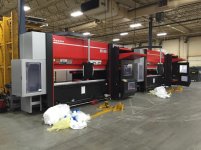Was looking at some press brake stuff and saw this system with CNC controlled upper and lower tooling. The lower tooling can either slide to make room for unbent sections:
Salvagnini press braking: B3.ATA upper & lower - YouTube
or another version can adjust the width automatically:
Salvagnini Press Brake with 1� second setup time - YouTube
This looks like it could save a lot of time on setups. Has anyone ever used it or seen it used?
Salvagnini press braking: B3.ATA upper & lower - YouTube
or another version can adjust the width automatically:
Salvagnini Press Brake with 1� second setup time - YouTube
This looks like it could save a lot of time on setups. Has anyone ever used it or seen it used?




